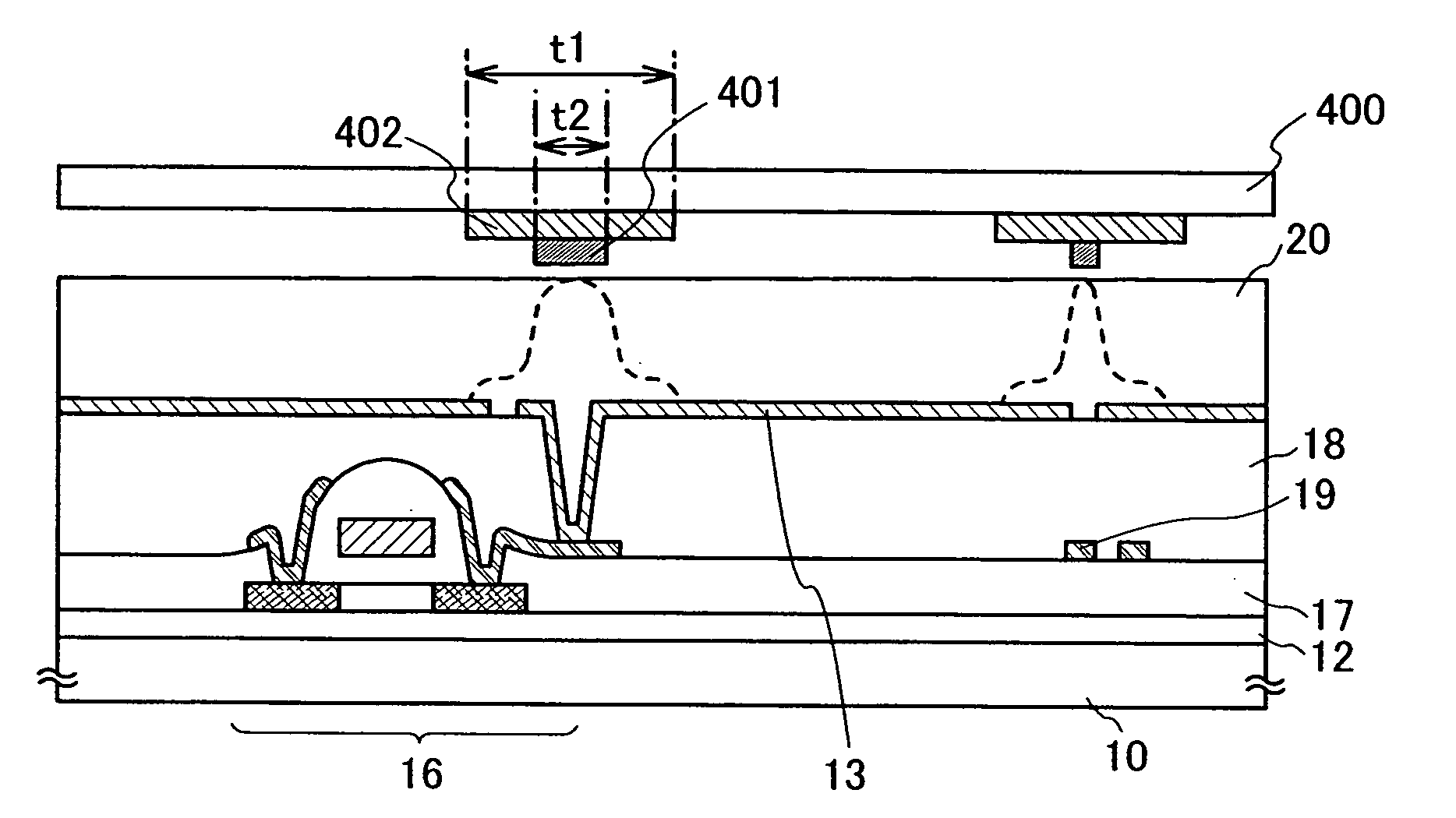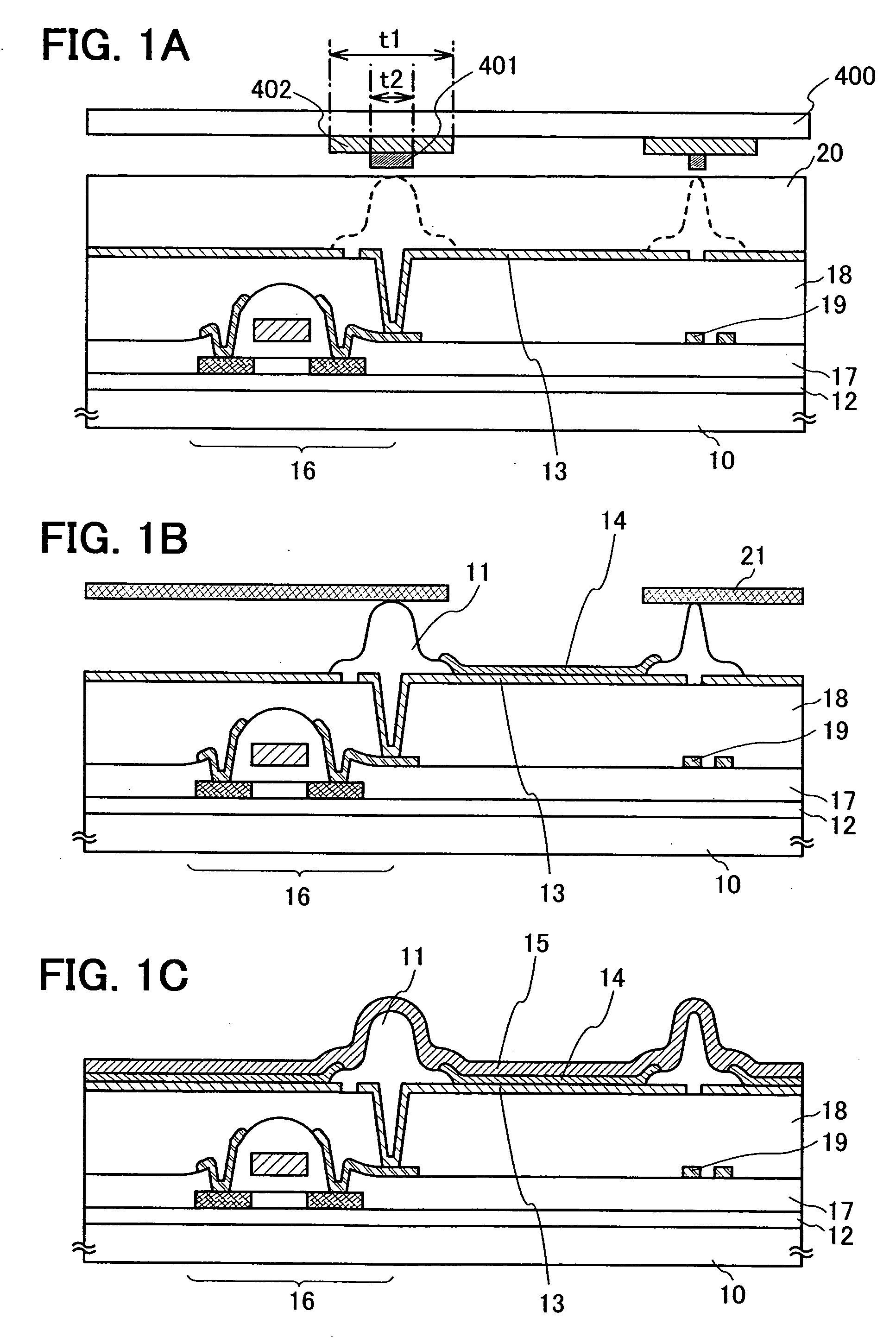Semiconductor device and manufacturing method thereof
a technology of semiconductor devices and semiconductors, applied in the direction of organic semiconductor devices, discharge tubes/lamp details, discharge tubes luminescnet screens, etc., can solve the problem of the size of a light emitting device, and achieve the effect of reducing the size of the partition, preventing defects, and increasing the number of steps
- Summary
- Abstract
- Description
- Claims
- Application Information
AI Technical Summary
Benefits of technology
Problems solved by technology
Method used
Image
Examples
embodiment mode 1
[0054] Here, the present invention is explained using an example of an active matrix light emitting device.
[0055] In addition, an example of a manufacturing process for obtaining a structure of FIG. 1C is hereinafter described.
[0056] First, a TFT 16 is manufactured over a substrate 10 having an insulating surface. As for a base insulating film 12 of the TFT 16 and a stacked layer 17 of insulating films including a gate insulating film, an inorganic material (such as silicon oxide, silicon nitride, silicon oxynitride, a SiOF film, or a SiONF film) obtained by a sputtering method or a PCVD method is used. As for an insulating film 18 functioning as an interlayer insulating film, an inorganic material (such as silicon oxide, silicon nitride, silicon oxynitride, a SiOF film, or a SiONF film) obtained by a sputtering method, a PCVD method, or a coating method; a photosensitive or non-photosensitive organic material (such as polyimide, acrylic, polyamide, polyimide amide, a resist, or b...
embodiment mode 2
[0080] This embodiment mode describes an example of a structure which is partially different from that of Embodiment Mode 1 with reference to FIG. 3.
[0081] Here, a structure in which one layer of the interlayer insulating film in FIGS. 1A to 1C is reduced, specifically, a structure in which the insulating film 18 shown in FIGS. 1A to 1C is not formed is described. Note that in FIG. 3, the same reference numeral is used to denote the same portion as that in FIGS. 1A to 1C.
[0082] Similarly to Embodiment Mode 1, a TFT 16 is manufactured over a substrate 10 having an insulating surface. Next, a first electrode 33 serving as an anode is formed over a stacked layer 17 of insulating films including a gate insulating film. The first electrode 33 is formed over the stacked layer 17 of insulating films including a gate insulating film so as to be partially in contact with and overlapped with an electrode electrically connected to a source region or a drain region of the TFT.
[0083] Next, an...
embodiment mode 3
[0089] This embodiment mode describes an example of providing a partition in a pixel portion where a plurality of light emitting elements is arranged (also referred to as a display region) and a structure arranged to surround the pixel portion.
[0090] Here, an example of manufacturing a passive matrix light emitting device is described with reference to FIGS. 4A and 4B.
[0091] A first electrode 303 is formed over a first substrate 301, and a partition 302 is formed to cover an end portion of the first electrode 303. In addition, a structure 304 is formed in the same step as the partition 302. The partition 302 and the structure 304 have different thicknesses. A cross-sectional view at this stage is shown in FIG. 4A.
[0092] Next, a layer 305 containing an organic compound is formed over the first electrode 303, and a second electrode 307 is formed thereover. Note that in forming the layer 305 containing an organic compound by an evaporation method, the structure 304 can prevent an ev...
PUM
 Login to View More
Login to View More Abstract
Description
Claims
Application Information
 Login to View More
Login to View More - R&D
- Intellectual Property
- Life Sciences
- Materials
- Tech Scout
- Unparalleled Data Quality
- Higher Quality Content
- 60% Fewer Hallucinations
Browse by: Latest US Patents, China's latest patents, Technical Efficacy Thesaurus, Application Domain, Technology Topic, Popular Technical Reports.
© 2025 PatSnap. All rights reserved.Legal|Privacy policy|Modern Slavery Act Transparency Statement|Sitemap|About US| Contact US: help@patsnap.com



